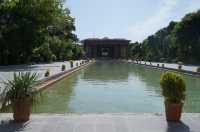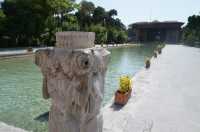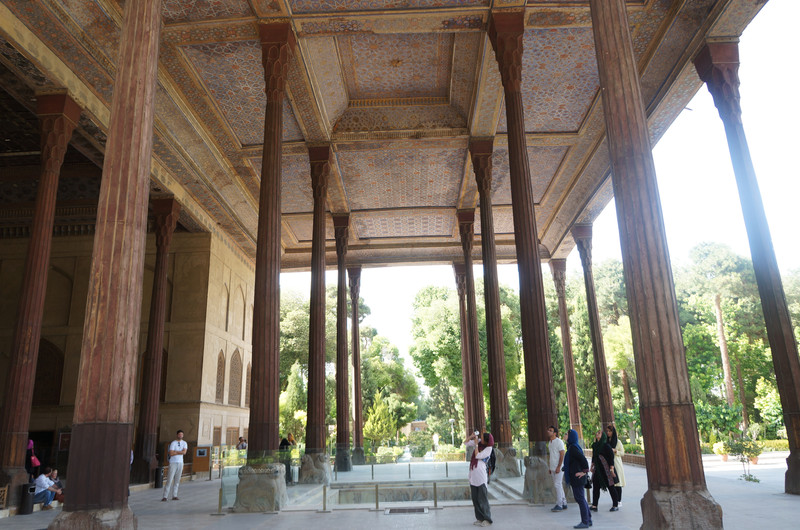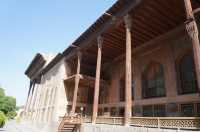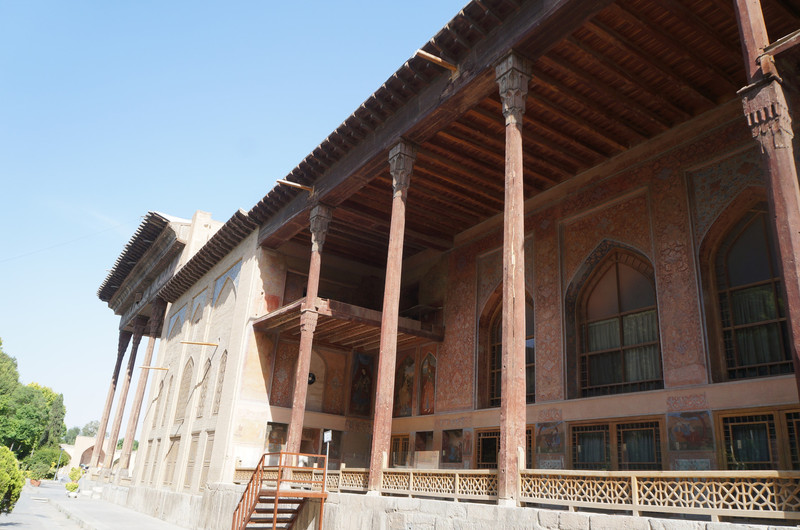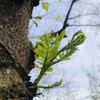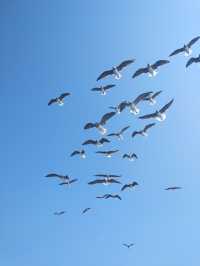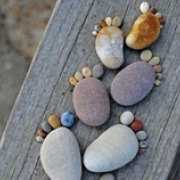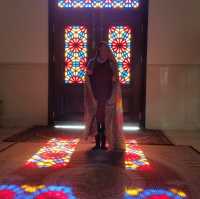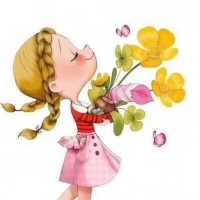Walking through the historical museum facing the street is the Forty Pillars Palace. At the ticket office at the door, we bought tickets for foreign tourists of 200,000 riyals per person, and the price displayed in Iranian text and numbers, the tickets for locals are 3,000 riyals, which is only equivalent to RMB 0.6 yuan. Such a large fare gap will inevitably affect the current industries such as hotels and taxis, and they will start learning from the government to treat our foreign tourists as "non-nationals" in price increases. The Forty Pillars Palace is one of the most important palaces of the Safavi dynasty (AD 1501-1736), completed in 1647, where the Safavi dynasty Abbas II received foreign envoys. Walking into the courtyard of the Forty Pillars Palace, I saw a magnificent palace at the top of the rectangular pool, with tall columns rising up to a tall dome. The palace actually only had twenty pillars, and because of the reflection of the water in the pool, it was named the Forty Pillars Palace. Around the pool and under the pillars of the palace pillars, there is a strange cat-like animal, said to be the lion of Iran, very demeanorless mascot. The walls of the colonnade are surrounded by pictures of the restoration process, and some of the colonnade is now being repaired with scaffolding. Through the colonnade, into the indoor hall, the small hall inside is a mural of varying sizes, huge murals on the characters, vividly recorded the glory of the Persian dynasty. According to the information, one of the large murals with group images reflects the scene of the Persian Empire's capture of Delhi, which can be seen at the time of the Persian Empire's territory. The small murals inside the palace, although colorful characters are vivid, always have traces of the remnants of the historical years.
;
Chehel Sotoon Palace Review
4.4 /534 Reviews
Popular Destinations
Haikou Travel | Nadi Travel | Dubai Travel | Chongqing Travel | Colombo Travel | Koh Larn Travel | Cebu Travel | Hangzhou Travel | Port Vila Travel | London Travel | New Delhi Travel | Docklands Travel | Hainan Travel | Da Nang Travel | Kyoto Travel | Miri Travel | Rockingham Travel | Spain Travel | Kas Travel | Perlis Travel | Appin Travel | Sutton Travel | Christiansted Travel | Hazyview Travel | Sparks Travel | Okanogan County Travel | Illmitz Travel | Nobeoka Travel | Swale District Travel | Tolentino Travel
Recommended Attractions at Popular Destinations
Bangkok attraction near me | Tokyo attraction near me | Manila attraction near me | Hong Kong attraction near me | Seoul attraction near me | Taipei attraction near me | Los Angeles attraction near me | New York attraction near me | Shanghai attraction near me | Shenzhen attraction near me | Kuala Lumpur attraction near me | Osaka attraction near me | Guangzhou attraction near me | Singapore attraction near me | London attraction near me | San Francisco attraction near me | Beijing attraction near me | Macau attraction near me | Bali attraction near me | Ho Chi Minh City attraction near me | Paris attraction near me | Orlando attraction near me | Jakarta attraction near me | Phuket attraction near me | Chicago attraction near me | Toronto attraction near me | Cebu attraction near me | Dallas attraction near me | Istanbul attraction near me | Dubai attraction near me
Popular Attractions
Gyeongbokgung Palace | SEA LIFE Sydney Aquarium | SEA LIFE Melbourne Aquarium | Tiananmen Square | Phuket FantaSea | Chao Phraya River | Jinshanling Great Wall | Wat Sai Floating Market | AQWA The Aquarium Of Western Australia | Hobbiton™ Movie Set Tours | Tokyo DisneySea | Ba Na Hills | Nanjing Road Pedestrian Street | Jump Mania Trampoline Park | Yarns Artwork in Silk Deloraine | Gumbuya World | Dafugu Temple | FONTANILE ORIETTA | Zona de picnic "la Parada del Jonquer" | Roof Park | Dasamma Garden | Border Post Cambodia–Việt Nam 106 | High Price Camphor | Dakotaland Museum | Orto Urbano | Kameiwa | El Montículo | TANAH LOT TEMPLE | Blue House | Patong Beach
Popular Travelogues
Bangkok Travelogue | Tokyo Travelogue | Hong Kong Travelogue | Seoul Travelogue | Los Angeles Travelogue | New York Travelogue | Shanghai Travelogue | Shenzhen Travelogue | Kuala Lumpur Travelogue | Osaka Travelogue | Singapore Travelogue | London Travelogue | Beijing Travelogue | Macau Travelogue | Bali Travelogue | Paris Travelogue | Phuket Travelogue | Toronto Travelogue
Payment Methods
Our Partners
Copyright © 2024 Trip.com Travel Singapore Pte. Ltd. All rights reserved
Site Operator: Trip.com Travel Singapore Pte. Ltd.
Site Operator: Trip.com Travel Singapore Pte. Ltd.
